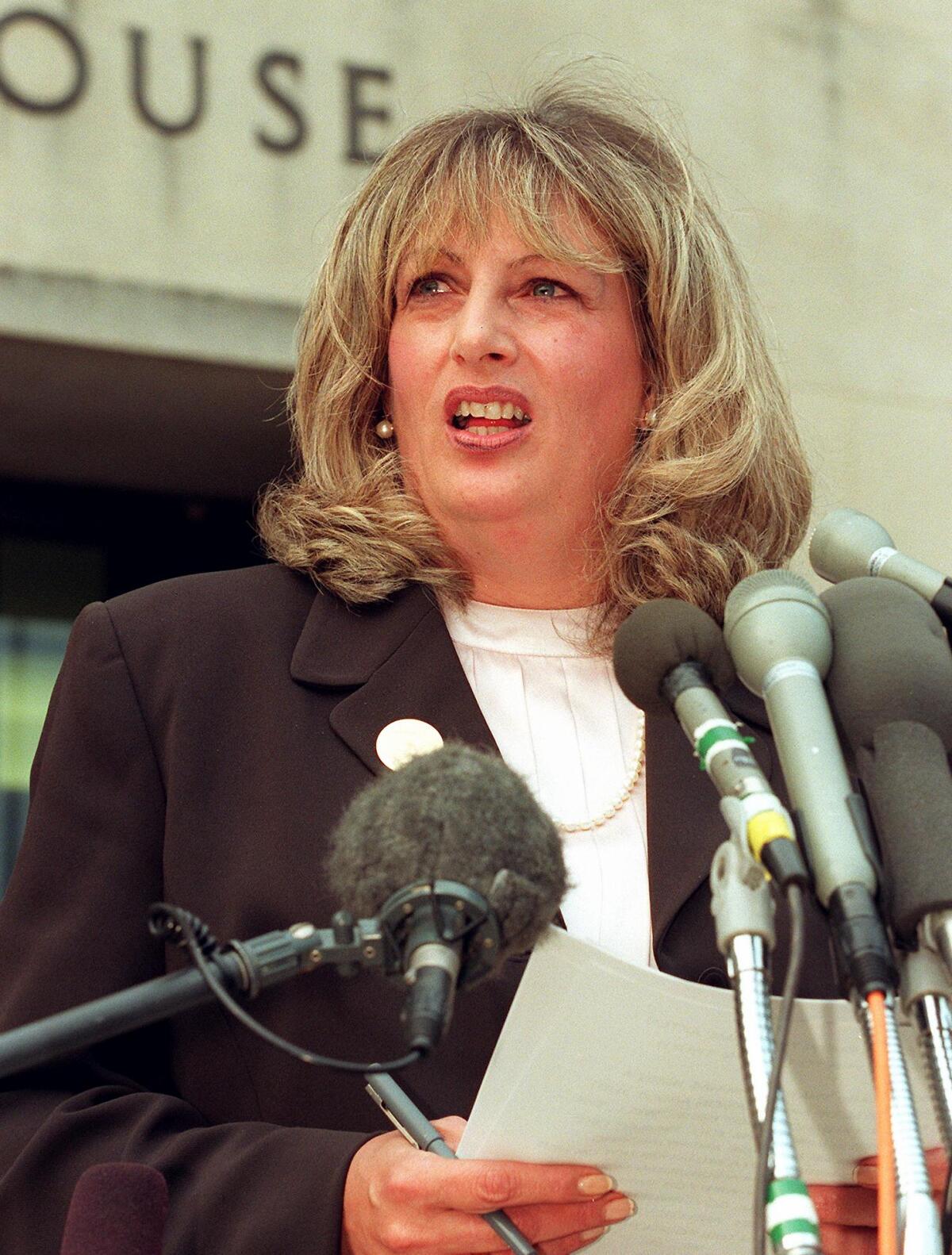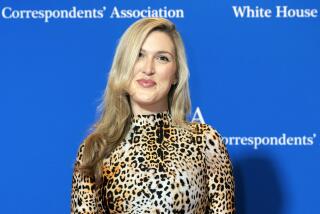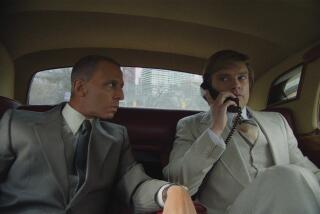Timeline: The Clinton impeachment, as it happened

- Share via
FX’s addictive new season of “American Crime Story,” from executive producer Ryan Murphy and head writer Sarah Burgess, is likely to reignite the nation’s interest in one of the defining scandals of the 1990s: the impeachment of President Bill Clinton. But just because it was one of the most-covered political stories in modern American history doesn’t mean it’s easily digestible.
“Impeachment” is, at its center, a story of human foibles, seen primarily through the eyes of three women at the center of the maelstrom: Paula Jones (Annaleigh Ashford), who accused Clinton of sexually harassing her when he was governor of Arkansas; Monica Lewinsky (Beanie Feldstein), who began a sexual relationship with Clinton as a White House intern; and Linda Tripp (Sarah Paulson), who secretly recorded Lewinsky discussing the relationship and exposed it to the media and investigators.
But viewers of “Impeachment,” which jumps around in time to dramatize nearly a decade’s worth of events, may want to accompany the series, which premieres Tuesday, with a straightforward guide to key developments in the scandal. Here’s a timeline of the Clinton impeachment, as covered by The Times:
The complete guide to home viewing
Get Screen Gab for everything about the TV shows and streaming movies everyone’s talking about.
You may occasionally receive promotional content from the Los Angeles Times.
Nov. 3, 1992: Clinton notches ‘stunning victory’ over President George H.W. Bush
On election day in 1992, the Arkansas governor, a self-styled “new kind of Democrat” who promised immediate help for the nation’s troubled economy, was well on his way to a lopsided victory over Bush, sweeping states and regions that Republicans had called their own for more than a decade.
Jan. 20, 1993: Clinton is inaugurated as the 42nd president of the United States
A crowd police estimated at more than 250,000 that extended from the Capitol grounds far down the Mall — the largest inaugural crowd ever — applauded and cheered as the accession of Clinton and Vice President Al Gore ended 12 years of Republican rule of the White House and marked a generational passing of the torch from 68-year-old George Bush to the first president born after World War II.
May 1993: ‘Travelgate’ erupts
Clinton Administration officials found themselves on the defensive over the firing of seven workers in the White House travel office — an incident that is fast becoming a metaphor for the political clumsiness and sour press relations that recently have dogged the President’s team.
July 20, 1993: Vince Foster found dead of self-inflicted gunshot wound
Foster, President Clinton’s 48-year-old deputy legal counsel, was found dead at Ft. Marcy, a small Civil War park overlooking the Potomac River in suburban Virginia outside the nation’s capital.
Foster had a role in the White House’s controversial firing of seven travel office employees, but he was not singled out for criticism in a White House review of the issue ... sources who knew Foster said he had been upset by negative publicity about the administration and his own role in it.
Linda Tripp, then an executive assistant in the White House counsel’s office, was among the last people to have seen Foster alive. In an interview with FBI agents after his death, Tripp recalled that Foster ate his lunch on a couch in his office while reading a newspaper. The agents wrote in their report: “He removed the onions from his hamburger, which struck Tripp as odd in retrospect. She couldn’t understand why he would do that if he was planning to commit suicide.”
After reclaiming Marcia Clark, the actor expected her latest role to change minds about ‘the most hated woman in America.’ She may have miscalculated.
Nov. 7, 1993: The origins of the Whitewater investigation, explained
The 1989 failure of a small Arkansas savings and loan has triggered criminal probes targeting some of President Clinton’s oldest friends and political allies, compelling the president to repeatedly deny allegations that he had a role in the debacle.
Claims that the governor lobbied the ailing thrift to hire his wife and that he urged Clinton-appointed judge David Hale to loan money that went into a Clinton-owned business have both been strongly disputed by the White House. But such allegations, raising questions about possible conflicts of interest and abuse of office by the then-governor of Arkansas, continue to be nettlesome because they are coming not from Clinton’s critics but from some of his oldest friends and supporters.
Nov. 29, 1993: Clinton allegedly assaults Kathleen Willey
In an interview with “60 Minutes” in March 1998, Willey, a former Clinton campaign worker and White House volunteer, claimed that Clinton kissed her, touched her breast and put her hand on his genitals during a 1993 meeting at the White House in which she sought a paid job — accusations Clinton denied. After the alleged encounter, Willey was given a part-time, paid staff position in the office of the White House counsel.
In August 1997, Tripp told Newsweek reporter Michael Isikoff that she encountered Willey in a hallway outside the Oval Office after the encounter, saying Willey’s “face was red, and her lipstick was off. She was flustered, happy and joyful.”
May 7, 1994: Paula Jones files lawsuit claiming Clinton sexually harassed her in 1991
Paula Corbin Jones, a former Arkansas state employee, filed an unprecedented lawsuit Friday seeking $700,000 in damages from President Clinton, whom she accused of making sexual advances in 1991 while he was governor of Arkansas.
Speaking for the President, attorney Robert S. Bennett denied the allegations detailed in the suit and dismissed them as “tabloid trash.” He told a news conference in Washington: “Quite simply, the incident did not occur.”
August 1994: Tripp departs White House for the Pentagon
At the Pentagon, Tripp made a swift impression according to testimony Clifford Bernath, then a deputy assistant secretary of Defense for public affairs, gave to the Starr investigation. “It must have been her first day or her second day, she said: ‘You know, I’m, I’m involved in … Vince Foster and I’m involved in a lot of things and I know a lot of things and this is why I need privacy and this is why I should be treated differently.’”
Within two months, Tripp’s behavior prompted Bernath to write a three-page memo about her. “She has been a disruptive force since her arrival and nothing we do seems to assuage her,” he wrote. He complained that she fought daily with co-workers, sending a barrage of nasty e-mail messages to anyone who disagreed with her.

August 5, 1994: Kenneth Starr named special counsel in Whitewater investigation
The controversial Whitewater criminal investigation took a surprising turn when a three-judge panel replaced special counsel Robert B. Fiske Jr. with Kenneth W. Starr, solicitor general under former President George Bush. Ironically, although the panel said that it needed to replace Fiske to assure the independence of the investigation because he had been chosen by the Clinton Administration, the switch actually could heighten the partisan nature of the inquiry.
While both Fiske and Starr are Republicans, Starr is widely viewed as a more partisan choice because of his service under Clinton’s 1992 political opponent and because he is said to have given legal advice to the lawyers for Paula Corbin Jones, the woman who is suing Clinton for alleged sexual harassment.
July 1995: Monica Lewinsky begins her White House internship
Lewinsky, then 21, was placed in the office of Chief of Staff Leon Panetta, according to the Starr Report. Her internship lasted until Nov. 26, 1995, at which point she began a paid position in the White House legislative affairs office that would last until April 1996.
Nov. 14, 1995: Five-day government shutdown begins
According to the Starr Report, it was during this government shutdown — with interns filling in for the nonessential federal employees sent home by the closure — that Clinton and Lewinsky first kissed in the the president’s private study, and engaged in their first two sexual encounters. They would have seven sexual encounters in all before Lewinsky’s transfer to the Pentagon the following spring, according to the report.
April 1996: Lewinsky is dismissed from the White House and transferred to the Pentagon
According to the Starr Report, Lewinsky was notified that she would have to leave her job at the White House on April 5, 1996. The report stated that Lewinsky burst into tears at the news: “I was never going to see the President again,” she said. “I mean, my relationship with him would be over.” Two days later, Lewinsky told investigators, Clinton promised to bring her back to the White House if he won reelection.
The third season of Ryan Murphy’s limited drama chronicles the impeachment through the eyes of the women involved: Monica Lewinsky, Linda Tripp and Paula Jones.
Nov. 1996: Clinton and Lewinsky seen on TV hugging at a rally
Take the shot seen around the world, a frame of TV footage showing Clinton and a smiling Lewinsky warmly hugging at a November 1996 rally. It’s become this story’s definitive freeze-frame, getting published in newspapers everywhere and shown repeatedly on U.S. newscasts, earning play even on news programs in Canada, England, France and Russia that were excerpted on C-SPAN Monday.
Nov. 5, 1996: Clinton reelected to a second term
President Clinton won a convincing reelection victory, capping a singular political comeback that promised him a place in history but was colored by signs of public ambivalence about his leadership and his party.
Feb 14, 1997: Lewinsky places a Valentine’s Day ‘love note’ in the Washington Post
According to the Starr Report, the ad, signed “M,” contained a quotation from Shakespeare’s “Romeo and Juliet”: “With love’s light wings did / I o’er perch these walls / For stony limits cannot hold love out, / And what love can do that dares love attempt.”
Feb. 28, 1997: Clinton and Lewinsky resume sexual encounters
Wearing the navy blue Gap dress that would later become an infamous part of the impeachment saga, Lewinsky attended the president’s weekly radio address and had her photo taken with the president, according to the Starr Report. In the president’s private study, Lewinsky told investigators, Clinton gave her belated Christmas gifts — a hat pin and a special edition of Walt Whitman’s “Leaves of Grass” and said he had seen her message in the Post. The two then had their first sexual encounter in nearly a year.
In later grand jury testimony, Clinton said of the encounter: “I was sick after it was over, and I was pleased at that time that it had been nearly a year since any inappropriate contact had occurred with Ms. Lewinsky. I promised myself it wasn’t going to happen again. The facts are complicated about what did happen and how it happened. But, nonetheless, I’m responsible for it.”

May 24, 1997: Clinton ends relationship with Lewinsky
Clinton told a weeping Lewinsky that the affair must end. Earlier in his marriage, she testified he told her, he had many affairs but had tried to become faithful. He was determined to resume that effort, she quoted him as saying, though he professed affection and admiration for her.
May 27, 1997: Supreme Court rules Paula Jones’ suit against Clinton can go on
The Supreme Court ruled that Clinton is not shielded from answering questions under oath or standing trial on sexual harassment charges just because he is president of the United States.
In a unanimous decision, the justices rejected Clinton’s claim that his high office with its unique burdens warrants giving him a “temporary immunity” from answering to civil lawsuits until he leaves the White House.
“The unofficial conduct of the individual who happens to be the president” is not a matter of constitutional concern, the court said.
While Clinton’s powers as chief executive cannot be infringed, the $700,000 damage suit filed in Arkansas by Paula Corbin Jones, a former state employee, concerns “alleged misconduct [that] was unrelated to any of his official duties,” wrote Justice John Paul Stevens.
Fall 1997: Tripp begins secretly taping phone calls with Lewinsky
Tripp precipitated the scandal with what appeared to be a stunning act of personal betrayal. But how could Tripp have done it? What were her motives? And how could Lewinsky have walked so blindly into the trap?
The answer that appears to emerge from transcripts of the tapes, plus grand jury testimony and other documents, is that resentment over what Tripp saw as her own mistreatment by the White House turned her into an implacable, self-commissioned secret agent bent on revenge.
Like a police detective building a bond of friendship with a suspect, Tripp made herself more than Lewinsky’s confidant. She became her counselor, her surrogate mother, her lifeline in a sea of troubles.
Dec. 28, 1997: Lewinsky makes her final visit to the White House
Officials familiar with records maintained by the Secret Service have said Lewinsky made at least 36 visits to the White House after she was transferred to the Pentagon in April 1996. Lewinsky last visited with Clinton at the White House on the evening of Dec. 28, 1997, when lawyers representing Jones in her sexual harassment lawsuit against the president were seeking to question Lewinsky under oath.
Jan. 12-14, 1998: Tripp informs Starr of her taped conversations with Lewinsky
Tripp decided to supplement her telephone tapes of Lewinsky with a recording made in person. She went to her lawyer and asked him to outfit her with a device called a body wire. He refused, and she fired him.
On Jan. 12, she took her request to Starr. Tripp telephoned Starr’s office and told about her conversations with Lewinsky. Starr’s investigators went straight to Tripp’s house and listened to the tapes, which appeared to contradict the president’s deposition and her own affidavit.
On Jan. 13, Tripp, working with the FBI, met Lewinsky at a Ritz-Carlton bar in Virginia and secretly taped their conversation.
On Jan. 14, Lewinsky gave Tripp typewritten tips on how to respond to questions from Jones’ lawyers. The “talking points” suggested ways to skirt the truth.
Jan. 16, 1998: Tripp lures Lewinsky into meeting for lunch at the Pentagon City mall
On Jan. 16, Starr quietly won formal approval to expand his Whitewater investigation. That same day, investigators working under Starr arranged for Tripp to invite Lewinsky to join her for lunch at the spacious Pentagon City mall in Arlington, Va., just across the Potomac River from Washington. Soon after the two women met, FBI agents approached, identified themselves and asked the pair to come upstairs to the 10th floor of the Ritz-Carlton Pentagon City. There, investigators had secured adjoining $139 rooms.
Jan. 17, 1998: Matt Drudge publishes story alleging Newsweek killed Clinton-Lewinsky reporting
The Drudge Report states that Newsweek editors had declined to publish a story involving “a young woman, 23, sexually involved with the love of her life — the President of the United States, since she was a 21-year-old intern at the White House.” The report set off a frenzy of talk radio, 24-hour news and the Internet usually reserved for a Watergate or a national crisis like the Gulf War.
Aug. 17, 1998: Clinton testifies before a grand jury and addresses the nation
In a grudging public admission after seven months of denial, Clinton told the American people that he had a relationship with Lewinsky that was “not appropriate, in fact, it was wrong.”
In a televised address that followed a historic day of testimony to a grand jury, Clinton also acknowledged lying to the public about his “private” conduct but steadfastly insisted that he had not asked anyone to lie or otherwise break the law.
“I misled people, including even my wife. I deeply regret that,” Clinton said.

Sept. 11, 1998: The Starr Report is published
After carrying on a sexual relationship with intern Monica S. Lewinsky inside the White House, President Clinton abused his presidential powers, committed perjury to cover up the affair and obstructed justice by attempting to win the silence of others, according to the independent counsel’s report.
Starr strongly recommended that Congress begin deliberating whether to remove Clinton as the 42nd president of the United States.
Dec. 19, 1998: House of Representatives approves two articles of impeachment against Clinton
The House, climaxing an exceptionally divisive confrontation between Republicans and Democrats, approved two articles of impeachment accusing Clinton of lying under oath and obstructing justice in the investigation of his relationship with former White House intern Monica S. Lewinsky.
Jan. 7, 1999: Senate trial of Clinton begins
In the trial, senators — 91 men and nine women — will have the power either to acquit the president or become the first in American history to fire a chief executive for “high crimes and misdemeanors.”
The rituals of the trial’s opening ended with a formal roll call, in alphabetical order, with each senator standing to reaffirm his or her oath with a simple: “I do.” One by one, they then lined up to sign a trial log attesting to their commitment to “do impartial justice,” using separate pens embossed with the words “United States Senate” that they got to keep as souvenirs.
Feb. 12, 1999: Clinton is acquitted by the Senate
The U.S. Senate acquitted President Clinton on two articles of impeachment, rejecting a Republican-led drive to force him from office on charges stemming from his affair with Monica S. Lewinsky.
The votes fell far short of the two-thirds majority needed to oust Clinton: the perjury charge was defeated, 55 to 45, while the vote on an obstruction of justice count ended in a 50-50 tie. All 45 Democratic senators supported acquittal. They were joined by 10 Republicans on the perjury charge and five on the obstruction count.
More to Read
The complete guide to home viewing
Get Screen Gab for everything about the TV shows and streaming movies everyone’s talking about.
You may occasionally receive promotional content from the Los Angeles Times.







